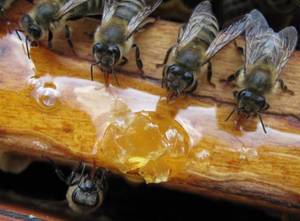
How bees collect pollen: collecting and discharging pollen
Trying to understand the process of honey production, the interested party has a lot of questions: how and where the bee collects pollen, as flower nectar turns into honey, how many grams of product one insect produces?
The insect's working day lasts until 18 hours. The worker carries out from 8 to 10 departures per day. The complexity of the production process determines the high cost of useful sweets.
"Intelligence operations"
All the inhabitants of the hive unquestioningly perform their duties. The work between insects is clearly divided. Flying or field bees make forays for pollen. They, in turn, are divided into scouts and collectors. Scouts can find a source of nectar within a radius of 4,5 km.
After finding food, they return to the hive and call for the help of cleaners by "dancing" in the air. If the insect flies in place, in a circle - the power supply found is nearby. If the bee is circling the trajectory of the eight - honey plants grow far from the hive. The smell is used as a reference for collectors, scouts. "Scouts" choose the best honey plants and lead them to collectors.
On the legs of the striped insect are special receptors, which help to recognize, whether there is nectar on the flower. The first thing bees look for flowers, contain nectar. If no such plants are found in the district, they switch to finding colors, containing pollen. It is possible to collect two substances at the same time only from plants 9 species. Others are designed to collect either nectar or pollen.
To increase the efficiency of the bee always marks the studied flowers. Nectar-containing plants insect denotes a special substance, attracting "relatives". "Empty" flowers they mark with a special repellent, drives away other insects. The best scout honeybees are marked with a special pheromone. This saves other insects from unnecessary work.
The role of pollen in the life of bees
The main task of the bee is to collect nectar. This is the first food product of the bee family. However, insects are sure to pick up the pollen crumbs available on the flower. Many underestimate the role of this substance and do not understand, why bees collect pollen. Pollen grains are actively consumed by young bees. This product is required:
- for active secretion of royal jelly;
- to build honeycombs;
- for the production of larval feed;
- for brood development;
- for the functioning of the pharyngeal glands.
Flower pollen (another pollen name) - vital food. It is rich in vitamin complex, proteins and amino acids. White, which is part of it, most needed by nursing bees, it promotes the production of royal jelly. It is food for the queen uterus and larvae of working individuals.
Due to the consumption of pollen, in insects, producing honey, pharyngeal glands work. Without protein supplement hypopharyngeal (or pharyngeal) iron is not formed at all. Total gland length - 2 cm, which is twice the body length of the insect. This body is responsible for 2 basic functions: production of milk for feeding larvae and secretion of special secretions, involved in the processing of nectar into honey.
Pollen is also needed to build honeycombs. Due to the sufficient number of flower stalks, wax iron functions in insects. Small glands are located on the stomachs of insects, where the "grains" of wax produced come from. The construction of the bee "home" is due to mutual assistance. One insect gives wax crumbs from the glands, the second chews them, forming a soft "ball", the third stretches the ball into a flat plate, which is used to form "hexagons".
Pollen collection (footsteps)
Everyone knows, why bees and bumblebees soar around flowering buds, but few know, where the bee collects pollen, how it carries it to the hive and how much product the bee family needs. To meet all needs (honey production, milk production, construction of honeycombs) a family of bees must collect before 20 kg of pollen.
Earth bees are useful and quiet neighbors
For the convenience of collecting the body of the insect is arranged in a special way. On the hind legs are special "pockets" - recesses with special bristles inside. To make pollen grains easier to carry in flight, the insect impregnates it with nectar and forms a dense ball. The bristles inside the "pocket" cover the lump and prevent it from falling out during the flight into the hive.
On the 3rd pair of legs of the insect are special brushes or "scrapers". Their detailed structure can be seen only under a microscope. "Scraper" consists of 9 rows of thin bristles-twigs. This brush helps the bee to clean the pollen powder, remaining on the hairs of the feet, abdomen and chest. When the flower is removed from the body, the insect places the "prey" in baskets on its hind legs with a brush. To remove all the grains from the body and put in a "pocket", the bee performs three stages of work:
- the first pair of legs removes pollen particles from the hair on the head;
- the second pair of legs cleans the breast;
- the third pair of legs cleans the abdomen.
Bumblebee collects pollen in the same way, like a bee. The combined apparatus of both insects has no differences.
